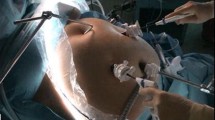Abstract
Staple line leakage and bleeding are worrisome complications of laparoscopic sleeve gastrectomy (LSG). Solutions such as buttressing, oversewing or roofing the staple line with gelatin matrix have been proposed with controversial results. Because the use of fibrin sealant has shown a possible benefit in reducing the reoperation rate due to early complication in patients (pts) undergoing laparoscopic Roux-en-Y gastric bypass (LRYGBP), this solution has been tested in 100 consecutive pts undergoing LSG. A clinical trial has been performed on 100 consecutive pts. Exclusion criteria from the study were considered ASA IV pts, treated or untreated malignancies at any stage, steroids or FANS assumption, previous sovramesocolic surgery and conversion to open surgery. All pts were randomized to receive (group A, 50 pts) or to not receive (group B, 50 pts) 4 ml of human fibrin sealant (Tisseel™, Baxter® Deerfield, IL, USA) sprayed along the suture line. Primary endpoint was the incidence of postoperative complications: leaks, bleeding of the staple line or stenosis of the gastric remnant. Significance was assigned at a p level <0.05. By considering pts in group A vs. pts in group B our results shown no significant difference in fistulas or strictures occurrence (p = 0.2). Bleeding was significantly higher in patients not sprayed with sealant (group A vs. group B, 1/7, p = 0.03). This randomized trial has so far shown the use of fibrin sealant in LSG to significantly reduce postoperative bleeding. Although a trend in reducing leak occurrence emerges, it does not reach statistical significance.
Similar content being viewed by others
References
Choi YY, Bae J, Hur KY, Choi D, Kim YJ (2012) Reinforcing the staple line during laparoscopic sleeve gastrectomy: does it have advantages? A meta-analysis. Obes Surg 22:1206–1213
Regan JP, Inabnet WB, Gagner M et al (2003) Early experience with two- staged laparoscopic Roux-en-Y gastric bypass as an alternative in the super–super obese. Obes Surg 13:861–864
Braghetto I, Csendes A, Lanzarini E, Papapietro K, Cárcamo C, Molina JC (2012) Is laparoscopic sleeve gastrectomy an acceptable primary bariatric procedure in obese patients? Early and 5-year postoperative results. Surg Laparosc Endosc Percutan Tech 22:479–486
Musella M, Milone M, Bellini M, Sosa Fernandez LM, Leongito M, Milone F (2012) Effect of bariatric surgery on obesity-related infertility. Surg Obes Relat Dis 8:445–449
Rosenthal RJ (2012) International sleeve gastrectomy expert panel. International sleeve gastrectomy expert panel consensus statement: best practice guidelines based on experience of >12,000 cases. Surg Obes Relat Dis 8:8–19
Dapri G, Cadière GB, Himpens J (2010) Reinforcing the staple line during laparoscopic sleeve gastrectomy: prospective randomized clinical study comparing three different techniques. Obes Surg 20:462–467
Gentileschi P, Camperchioli I, D’Ugo S, Benavoli D, Gaspari AL (2012) Staple-line reinforcement during laparoscopic sleeve gastrectomy using three different techniques: a randomized trial. Surg Endosc 26:2623–2629
Parikh M, Issa R, McCrillis A, Saunders JK, Ude-Welcome A, Gagner M (2013) Surgical strategies that may decrease leak after laparoscopic sleeve gastrectomy. A systematic review and meta-analysis of 9991 cases. Ann Surg 257:231–237
Musella M, Milone M, Bellini M, Leongito M, Guarino R, Milone F (2011) Laparoscopic sleeve gastrectomy. Do we need to oversew the staple line? Ann Ital Chir 82:273–277
Silecchia G, Boru CE, Mouiel J, Rossi M, Anselmino M, Morino M, Toppino M, Gaspari A, Gentileschi P, Tacchino R, Basso N (2008) The use of fibrin sealant to prevent major complications following laparoscopic gastric bypass: results of a multicenter, randomized trial. Surg Endosc 22:2492–2497
Brolin RE, Lin JM (2013) Treatment of gastric leaks after Roux-en-Y gastric bypass: a paradigm shift. Surg Obes Rel Dis 9:229–233
Casella G, Soricelli E, Rizzello M, Trentino P, Fiocca F, Fantini A, Salvatori FM, Basso N (2009) Nonsurgical treatment of staple line leaks after laparoscopic sleeve gastrectomy. Obes Surg 19:821–826
Hutter MM, Schirmer BD, Jones DB, Ko CY, Cohen ME, Merkow RP, Nguyen NT (2011) First report from the American College of Surgeons Bariatric Surgery Center Network: laparoscopic sleeve gastrectomy has morbidity and effectiveness positioned between the band and the bypass. Ann Surg 254:410–422
Pereferrer FS, Gonzalez MH, Rovira FA et al (2008) Influence of sleeve gastrectomy on several experimental models of obesity: metabolic and hormonal implications. Obes Surg 18:97–108
Melissas J, Koukouraki S, Askoxylakis J et al (2007) Sleeve gastrectomy—a restrictive procedure? Obes Surg 17:57–62
Gagner M, Deitel M, Kalberer TL, Erickson AL, Crosby RD (2009) The second international consensus summit for sleeve gastrectomy, March 19–21, 2009. Surg Obes Rel Dis 5:476–485
Aurora AL, Khaitan L, Saber AA (2012) Sleeve gastrectomy and the risk of leak: a systematic analysis of 4,888 patients. Surg Endosc 26:1509–1515
Deitel M, Gagner M, Erickson AL, Crosby RD (2011) Third International Summit: Current status of sleeve gastrectomy. Surg Obes Relat Dis 7:749–759
Glaysher M, Khan OM, Mabvuure NT, Wan A, Reddy M, Vasilikostas G (2013) Staple line reinforcement during laparoscopic sleeve gastrectomy: Does it affect clinical outcomes? Int J Surg 11:286–289
Ballanger DE, Greenway FL (2011) Laparoscopic sleeve gastrectomy, 529 cases without a leak: short-term results and technical considerations. Obes Surg 21:146–150
Baker RS, Foote J, Kemmeter P et al (2004) The science of stapling and leaks. Obes Surg 14:1290–1298
Conflict of interest
None.
Author information
Authors and Affiliations
Corresponding author
Rights and permissions
About this article
Cite this article
Musella, M., Milone, M., Maietta, P. et al. Laparoscopic sleeve gastrectomy: efficacy of fibrin sealant in reducing postoperative bleeding. A randomized controlled trial. Updates Surg 66, 197–201 (2014). https://doi.org/10.1007/s13304-014-0257-0
Received:
Accepted:
Published:
Issue Date:
DOI: https://doi.org/10.1007/s13304-014-0257-0



